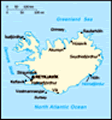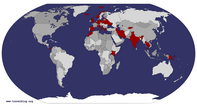Advertisement
Published: August 29th 2014
Iceland was somewhere I’d wanted to visit for a long time, but the cost had always put me off. A pint of beer for twelve pounds, a puffin fillet for thirty quid – Iceland was one of the most expensive places to visit in the world. Then something happened to change this outlook: the Icelandic krona took a nose dive and, overnight, Iceland became an affordable destination.
The Icelandair Boeing 757 delivered me punctually into Keflavik airport and I was soon aboard the Flybus heading into the city centre. The driver was a buxom blonde with rosy red cheeks. If she had been wearing animal hides, she could’ve passed as a Viking wife.
The countryside was rocky, hostile and mossy. Later I learned the rocks were lava deposits, a legacy from the island’s volcanic heritage. The more I looked, the more rocks and lichen I could see, and then I realised the scenery reminded me of Scotland: dramatic and jagged, beautiful yet treacherous. Something caught my eye: a plume of smoke escaping from one of the distant peaks. The last thing I needed was to be stranded in Iceland while a cloud of ash blew over Europe grounding every
flight in its wake. I muttered to myself in consternation.
“Are you looking at that ash flow?” asked a man’s voice from the seat behind. His English diction was perfect, though with a slight accent. I turned to see a middle-aged gent in a business suit. Like the driver, he had rosy cheeks and a wide face: an Icelander.
I nodded and smiled.
“All tourists stare at the ash clouds. Do not worry. It will not cause any disruption for you. It is a normal occurrence in my country. By the way, my name is Magnus.”
“I’m Jason.” I said. “So eruptions like this are common?”
Magnus nodded. “But what you are looking at is not an eruption; it is just some gas escaping: a new born baby compared to the monster that grounded every flight a while ago. You remember that?”
I nodded again. For six days in April 2010, tens of thousands of flights across northern Europe had been cancelled. Twenty countries had shut down their airspace, creating an aircraft blackout not seen since the Second World War. It cost the airlines $1.7 billion in lost revenue and affected ten million people’s
travel plans. But it seemed a repeat of that event was not likely.
I began to read a tourist newspaper that had been left on the seat by a previous passenger. The mayor of Reykjavik, Jon Gnarr, wrote the article and the main thrust of his piece was to ask tourists to spend their money in Iceland. ‘Spend, spend, spend’ was his simple message: the only way the Icelandic economy could recover, he claimed
Another money-spinner for Iceland was its prime location. It was halfway across the Atlantic, mid-distance between Europe and North America. Icelandair had made great moves in establishing Reykjavik as a popular transit point between both continents, and indeed my flight from Manchester had been full, mostly with Americans. The elderly couple seated next to me were from the US city of Minneapolis. I knew this not because I'd spoken to them, but because I’d secretly read the ticket stub of the wife. I had no desire to speak to either of them because of what happened when I’d boarded the plane.
Iceland Air I was one of the last passengers to board the aircraft, and as I reached my row, I
noticed the golden oldies immediately. The husband was sitting in the aisle seat eying me balefully as I manoeuvred my hand luggage into the overhead bin. His wife was sitting snugly in my seat (the window seat) leaving the middle one empty. They had obviously been hoping that the seat would remain empty. My presence had dashed that hope for them and now they hated me.
I looked at the woman and smiled. “Hi. You’re in my seat, but if you want to stay by the window,” I said, “that’s fine.” I directed my gaze to the husband. “So if you just move to the middle, I’ll sit in the aisle.”
The old goat’s reaction surprised me. After grimacing, he wobbled a pair of large red lips over his gnashing teeth. “No, son!” he snarled. “I’m not moving one inch. I’ve got a bad leg!” He sat back and folded his arms, seemingly satisfied that he'd sorted me out. His wife glared too, and then looked out of the window.
Okay, I thought, two can play at this game. With a full aircraft, and a lot of people staring, I looked at the old man
and gestured to the window seat. “Your wife is sitting in my seat. Out of courtesy to her, I don’t mind if she stays there, but you need to move over.”
“I said I’m not moving,” he repeated in his Minneapolis drawl. “So don’t ask again.”
I was flabbergasted. The cheek of the old git! With forty pairs of eyes upon me, including both obstinate pensioners, I decided to play hardball. “Yes, you are. Both of you move so I can have my window seat.”
The old couple looked at me with pure, undisguised loathing. I stood my ground until a member of the cabin crew came over, checked my ticket stub, and asked them to move too. It took a while, but I waited patiently. As I settled down in my warm window seat, I mentally crossed Minneapolis off from places to visit in the US. Neither of the pensioners looked at me for the rest of the flight, which was fine by me.
Sunny Reykjavik Reykjavik was sunny and pleasantly warm by the time I arrived at my hotel. I didn’t have to worry about the sun going down because sunset was around
midnight in the summer months. After unpacking a few things, I left the hotel and found myself in a small square called Ingolfstorg. It was full of skateboarding teenagers and steam vents. I wandered towards the sea, enjoying the warm, fresh air of Iceland.
The Sun Voyager is one of the most photographed sculptures in the city. Made of steel, the skeletal Viking ship sculpture was in a prominent position overlooking the harbour. It looked incredible, resembling a fish skeleton made from silver, except boat-shaped. It was surprisingly large and, while I marvelled at the way sunlight caught the steel ribs, a young couple arrived and stood waiting for me to finish taking a photo. I did, and then stood staring out across the bay. The opposite side of the inlet looked brooding and uninviting; long, flat-topped hills shrouded in grey mist: the abode of monsters – monsters that ate woolly mammoths and chewed on Viking skulls. Feeling a slight chill in the air, I turned heel and headed inland.
Hallgrimskirkja The Hallgrimskirkja Church jutted into the sky for 75 metres, making it the third-tallest building in Iceland. It looked like no other church I’d seen,
full of sweeping, graceful angles that led up to the majestic white tower. It was one of the most striking churches I had ever laid my eyes upon and I simply could not stop staring. Other people were gazing upwards too, and, to take advantage of the crowds, a mobile hotdog vendor had set up shop on the road opposite. He was doing brisk business.
I ignored the hotdogs and wandered to a large statue in front of the church. It was of Leif Ericson, an Icelandic Viking who had discovered the New World five hundred years before Columbus. Standing with his chin turned to the elements and a large battle axe by his side, Ericson looked the epitome of a Norse hero.
For 600 krona (£3), I bought a ticket to the observation deck inside Hallgrimskirkja’s mighty tower. The views were stunning, covering the entire city and beyond. Reykjavik was a low-rise city, and many of the buildings had red, green and white roofs, giving them an almost toy-town feel. And the air was beautifully clean; I could see for miles, into the far reaches of the gun-grey Atlantic Ocean. Suddenly an almighty racket above our heads broke the peace. The church bells were chiming for 7pm. For me, it signalled time for food, followed by rest in the hotel. I had a full day the next day, the first of many in the coming weeks.
If you have enjoyed this small section about my trip to Reykjavik, then maybe you'll enjoy my book about visiting Iceland and 21 other European countries. It's called Rapid Fire Europe by Jason Smart, available on Amazon. http://www.amazon.co.uk/Rapid-Fire-Europe-European-Countries-ebook/dp/B00MR3HZYC/ref=la_B00B75IKJA_1_9?s=books&ie=UTF8&qid=1408897624&sr=1-9
Advertisement
Tot: 0.073s; Tpl: 0.01s; cc: 10; qc: 23; dbt: 0.0297s; 1; m:domysql w:travelblog (10.17.0.13); sld: 1;
; mem: 1.1mb













D MJ Binkley
Dave and Merry Jo Binkley
Iceland
One of our favorite countries.